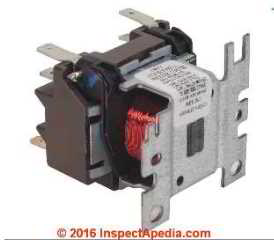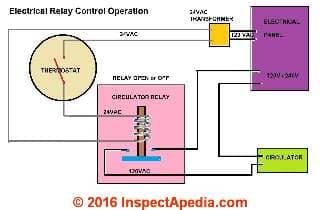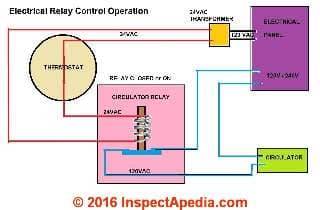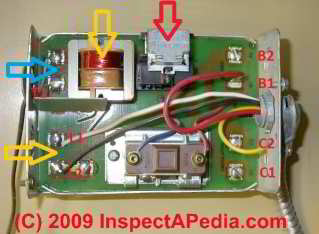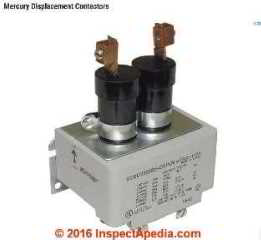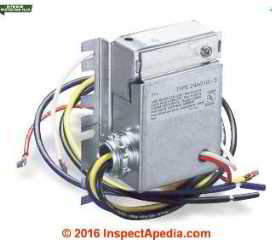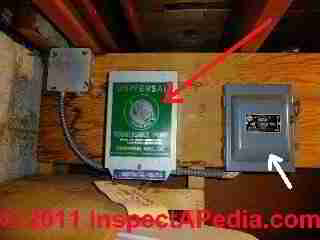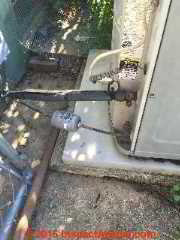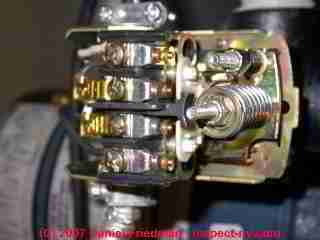 Relay Switches & Contactors
Relay Switches & Contactors
Causes & repairs for buzzing, clicking chattering relay switches in Air Conditioners, Heat Pumps, Water Pumps, & other controls
- POST a QUESTION or COMMENT about contactor switch or relay switch noises in mechanical systems used in buildings or building air conditioners, heat pumps, water pumps or other equipment
Control relay switch chattering noises might also be described as buzzing, clicking, clicking, humming sounds.
This article explain control relay switch chattering or rapid, repeated clicking noises, their cause, meaning, and repair. Relay switches are widely used to control equipment found in or on buildings including air conditioning system or heat pump compressor/condenser unit compressor motors, fans, and in an air handler the blower fan used in forced air heating and air conditioning systems.
Relays are used to switch on or off backup heat for heat pump systems. Control relays are also used to control water pumps in private well systems or in water pressure booster systems.
Shown at page top: the relay switch in a water pump pressure control switch.
InspectAPedia tolerates no conflicts of interest. We have no relationship with advertisers, products, or services discussed at this website.
Clicking or chattering electrical relay switches
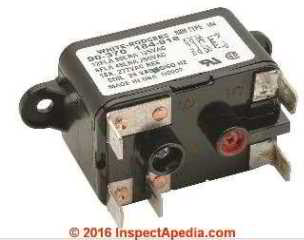 Article Contents
Article Contents
- RELAY CONTROL SWITCHES
- CAUSES of CONTACTOR / RELAY CHATTER
- CONTACTOR REPAIR, CLEANING POINTS - temporary repair success
- AIR CONDITIONER / HEAT PUMP RELAY SWITCH CONTACTOR CHATTERING
- HEAT or ELECTRIC HEAT CONTACTOR SWITCH CHATTER
- WATER PUMP CONTROL SWITCH CHATTER or BOUNCE
- WHERE to BUY REPLACEMENT RELAYS
- A/C CONDENSER CHATTER / BUZZ REPAIR SUCCESS
[Click to enlarge any image]
What is a Relay or Contactor Switch, How do They Work & Why Are They Used?
Shown here: A typical general-purpose relay switch or contactor produced by Honeywell. [Click to enlarge any image] If you hear buzzing or chattering at this relay it probably needs replacement.
An electrical relay is a device that changes the state of a circuit
in response to it being energized or de-energized by that or
another circuit. -
(Roberts 2006, copy available atReferences or Citations )
In typical mechanical systems used in buildings, such as air conditioners, heat pumps, electric heat, and water pumps, one or more electromagnetic relays are used to control the operation of these devices.
The relay is basically an on-off switch that uses a lower current circuit to switch on or off a higher current electrical circuit (and thus device). There are several reasons that these controls are used:
- To permit using a light-duty low-voltage switch (like a thermostat) to operate a heavier duty higher-voltage piece of equipment (like an air conditioner).
In this case the thermostat, in response to room temperature, changing temperature moves or operates a low-voltage switch inside the thermostat.
That thermostat switch, powered by a low-voltage thermostat wiring (18-gauge) circuit (24VAC), operates a physically separate relay switch or "contactor switch" (located in the heater or air conditioner) that turns on or off a heavier-use wiring (14, 12 or higher gauge) circuit wiring a higher voltage (120VAC or 240VAC) that in turn will operate the air conditioner or heat pump.
Thermostats used to control heating & cooling equipment are described separately
at THERMOSTATS, HEATING / COOLING - To permit another external force or condition a heavier duty higher-voltage piece of equipment (like an water pump).
In this case water pressure pushing on a spring-operated diaphragm mechanically operates or moves the relay contacts to close or open the switch to turn on or off the water pump.
Pump control switches are described separately
at WATER PUMP PRESSURE CONTROL.
How a Typical Relay Switch Switch Works
[Click to enlarge any image]
A low voltage switch such as a wall thermostat used to turn heat or air conditioning on and off operates at 24VAC, at very low current (Amps), and cannot handle the switching of higher voltage (120V or 240V) to higher-current-using mechanical systems that might run at 20 to 40 Amps.The low-voltage 18-gauge wiring and the little "switch" in the thermostat would burn or melt at those higher currents.
So we use the little low-voltage, low-current switch (such as a wall thermostat) to operate a contactor or relay that in turn operates the higher current circuit.
Current through the electromagnetic coil in the relay operates a magnet in the relay (pink rectangle in the illustration) that in turn mechanically closes electrical contacts (blue) that are designed and rated to handle the voltage and current of the device being operated. In our image of a Honeywell brand relay control (earlier on this page) you can see the magnetic coil - those red-copper windings are part of the coil assembly.
In our sketch above we've simplified a schematic of the operation of an electrical relay, in this case we illustrate a circulator relay control used to control the circulator pump of a hot water heating system. When the thermostat is not calling for heat the low voltage switch in the thermostat is in the Open position and the circuit is not energized. This is a Normally Open or NO relay. Items are of course not shown to relative scale.
When a thermostat or similar switch "closes" to operate a circuit, that sends voltage, typically 24VAC through the coil assembly. That coil creates an electromagnetic field that in turn energizes a magnet in the center of the coil, causing the magnet to move up or down.
The moving magnet, in turn, moves contacts (not visible) that close the relay switch to turn on the higher current/amperage circuit.
In the case of our sketch of a relay switch operation shown above, the coil is energized, the magnet has moved the contactor in the relay "up", closing the 120VAC electrical circuit and thus permitting the circulator pump motor to run.
What's the Difference Between a Relay Switch and a Contactor?
Shown above, a hydronic heating system circulator pump relay control with its cover removed. The basic components and connections in the circulator relay include:
- Green arrow: Line voltage in - 120VAC power to operate the circultor pump (white and black wires) usually labeled L1 and L2
- Blue arrow: thermostat wires - low voltage circuit from thermostat that operates the circulator relay usually labelled T and T1
- Yellow arrow: 24VAC transformer that operates switches and controls within the relay control assembly
- Red arrow: the circulator relay switch
- Circulator control terminals C1 and C2 are at the lower right side of the circuit board in our photo
- Burner control terminals B1 and B2 are at the upper right on the circuit board in our photo
Troubleshooting an aquastat and its relays is
at AQUASTAT TROUBLESHOOTING
Also see CIRCULATOR PUMP RELAYS & OTHER CONTROLS.
We use the terms "relay switch" and "contactor" or "contactor switch" synonymously in this discussion. Reading literature on repair and maintenance of residential and light-commercial mechanical systems such as residential or light-commercial air conditioners, heat pumps, hot water heating system circulator pumps, and water pumps, we see that technicians regularly use the terms "relay" and "contactor" as if they were the same thing.
Both contactors and relays are switches used to turn on or off an electrical circuit in response to some condition (temperature, water pressure, other). And both types of devices use a type of electromagnetic coil to move the switch to cause it to open or close.
Technically these two devices are not identical. Most-basically relays operate lower-current devices and contactors are used to operate higher-current equipment. Everything else I add below is simply adding detail to the differences in current or load that the switch is controlling.
So in a higher-current air conditioner or heat pump system the service technician using the term "contactor" is correct, while in a lower-current hydronic heating system in which a room thermostat is operating a circulator pump, the heating service technician using the term "circulator pump relay" is correct.
The functional or usage difference between a contactor and a relay is that
- Relays or relay switches control comparatively low-voltage equipment such as a 120V or 240V well pump or furnace or heating boiler or air conditioners. A relay switch will have at least two contacts and is operated by an excitation coil.
I think of this as a "weaker" lighter-duty coil than the electromagnetic coil used in a contactor. Relays are typically used for control switching and do not handle very high ampere circuits.
Relay switches typically handle up to about 20 Amps and are sold usually in normally-open (NO) configuration but can be purchased in normally-closed (NC) versions too.
Some relays such as those used on a water or well pump can be used in two ways: to actually switch the end-device (a lower horsepower water pump) or to switch a heavier duty contactor that in turn switches the end-device (a water pump of higher horsepower) that draws more current (amps).
In this article WATER PUMP CONTROL SWITCH CHATTER or BOUNCE on this page you will see photos of both the pressure control switch or relay and a separate wall-mounted heavier-duty contactor in a separate control box. - Contactors or contactor switches control high-voltage, often-commercial equipment such as large industrial motors, capacitors, lighting circuits. A contactor will usually have at least one pair of three-phase input and output contacts.
Contactors can handle up to about 12,500 Amps.
Most contactors are sold in the normally-open (NO) design and require an external electrical current on the input contacts to close the switch and thus activate the circuit. The contactor is mechanically operated by one or more contactor coils that are energized (closing the contactor switch) when an input current is applied or de-energized (opening the switch) when the input current is removed.
Contactors are also sold in normally-closed (NC) versions and in AC or DC versions to meet current loads of various amperes and to switch power on or off to equipment.
What Noises Occur at Relay Switches or Contactors? Causes of clicking or chattering noises at a relay switch
While some noise is common at these relay controls, clicking or chattering noises are common complaints we hear from both consumers and repair technicians. While many sources pose causes and cures for chattering or clicking at electrical relay controls, none of them proved comprehensive and some pose more legend than objective data.
Here we have collected, explained, and offer comments on causes and cures for relay clicking and chattering problems.
According to Schneider Electric, some humming noise is normal at contactors or relays used with HVAC relays, and in larger mechanical equipment and relays humming and vibration are normal.
Basically, all AC devices which incorporate a magnet and armature assembly produce a characteristic hum. This hum is largely due to the changing magnetic pull (known as the flux change) which induces mechanical vibrations. - Schneider Electric, retrieved 2016/08/01, original source: http://www.schneider-electric.us/en/faqs/FA93442/
But if your contactor or relay switch is clicking on and off rapidly or making a chattering noise, that's probably not normal and merits diagnosis and repair.
Watch out: testing and repairing electrical components or HVACR equipment involves potentially fatal shock hazards - you could be killed. If you are not trained and qualified to work on electrical equipment you should not touch it and should hire a trained professional such as a licensed electrician or a trained HVACR technician.
Also see DMM DIGITAL MULTIMETER HOW TO USE or for VOM use
see VOLTS / AMPS MEASUREMENT EQUIP.
Watch out: for chattering or rattling noises at an air conditioner compressor motor itself, especially in cold weather the problem may be failure of the crankcase heater.
See AIR CONDITIONER / HEAT PUMP RELAY SWITCH CONTACTOR CHATTERING
Causes of & Diagnostic Tips for Contactor or Relay Chattering / Rapid Clicking
Chattering or clicking on and off very rapidly, perhaps multiple clicks per second, occurs only on electromechanical relays.
The most-common cause of chattering in contactors or relays in HVACR equipment is imperfect contact between the two contact surfaces or points. That contact problem may be due to burning or pitting of the contact surfaces or less often due to mechanical damage to the contactor switch assembly. About equally common is an accumulation of dirt or debris interfering with good electrical contact between the contacts.
Causes of contactor relay chatter and clicking include these items, arranged in order alphabetically rather than in order of probability:
- Age, wear & tear in the contactor: depending on the environment, duty cycle, and operating voltage range, a contactor relay assembly will fail from aging effects that include deterioration of the varnish encapsulating the contactor coil winding, broken cracked coil insulation, or runout of varnish that binds moving contactor coil parts.
Contactors located in hot environments or in locations that are poorly-ventilated will age and fail more quickly. Contactors located in corrosive environments (industrial settings, swimming pool chlorine exposure etc.) also age and fail more rapidly.
If the contactor chattering has been a problem since-new check for under-sized wiring between controller and relay; check also that the common wire between the controller and the start-relay (for a water pump for example) is a dedicated wire; some techs note specifically that you should not share a common wire from solenoid switches with the relay itself.
Check also for loose or bad wiring connections anywhere in the circuit.
If the contactor / relay chattering is a recent problem on equipment that was previously working properly, other than "aging effects" cited just above, check the other possible causes in the rest of this list, starting with dirt in the contactor assembly or on the contact points or in the contactor's coil. - Auxiliary contactor: A faulty auxiliary contactor (present on some compressor/condenser systems in air conditioners or heat pumps
- Burned contact points or overheating of the relay assembly caused by high or excessive current flowing through the device for any reason, such as overloading or even a short circuit. Very high current will often cause actual melting of the contact points or mechanical damage to the contactor parts - a useful diagnostic clue.
A variety of contact materials are available [for use as the electrical contact point surface], with characteristics suitable for the various applications. For very low-current, low voltage applications (dry circuit), it is essential to select contact materials that do not oxidize, develop insulating coatings, or erode mechanically.
Some precious metals (such as gold and platinum) and some proprietary alloys satisfy these requirements. Such contacts are used in choppers and in meter relays, in which contact-sticking can be a serious problem.
... Dry metal contacts may fail by welding together; mercury contacts seldom do this. Relays with mercury contacts must usually be mounted in a nearly vertical position, and they are often vibration-sensitive.
... when larger currents must be handled (especially if the load is inductive or if it experiences an appreciable inrush for any reason), steps should be taken to protect the contacts from the effects of arcing, sparking, or welding. Under certain conditions, arcs tend to develop between contact and case or between contact and mounting. - Roberts 2006, copy available atReferences or Citations - Capacitor defects: aside from loose wiring at a motor start capacitor, a failing capacitor or one that is loose and vibrating might contribute to chattering or clicking at the starting contactor or relay.
See CAPACITOR TYPES, for MOTORS and
see CAPACITORS for HARD STARTING MOTORS - Contactor coil defects:
- Contactor coil is under-sized: Under-sized or improperly sized replacement coil in a contactor relay assembly
- Contactor shading coil is broken, jammed, or damaged
- Contactor or relay coil is mechanically damaged so that the moving parts are ms-aligned, such as between the armature and the magnet assembly, or its internal spring is damaged
- Contactor / relay coil is dust or dirt contaminated so that its moving parts jam
- Also effects of age, corrosion, dirt can damage the coil and prevent movement or proper operation; in turn that means that the contact arms will either fail to move at all (the contact won't open or close, or they may fail intermittently, or may chatter.
- Corrosion on the contactor points or on any of its metal parts, particularly moving parts, or in the contactor relay magnetic coil can prevent good electrical contact at the points or can prevent proper movement of the contactor assembly.
- Current supply insufficient: insufficient current (amps) at the relay from the controller or control board can cause the relay to fail to close or can cause chattering; other items in this contactor / relay troubleshooting list may explain the low current.
- Current draw too high : Excessive current (Amps) draw from the motor that the contactor or relay is attempting to operate will burn or melt contact points or cause other damage; high current draw may be due to a seized or seizing electrical motor, inadequate wiring, or low voltage in the electrical supply system.
See HARD STARTING COMPRESSOR MOTORS and
also BURNED-OUT COMPRESSOR and also
see DIAGNOSTIC TABLE for WATER PUMPS
Excessive current draw from an A/C or heat pump compressor motor trying to start against high head pressure. High head pressure might in turn be caused by a failing TEV or high pressure control or by a blockage in the condensing coil itself. - Dirt in the contactor / relay assembly: Dust or dirt, oil, insects, mouse droppings or any other contaminant in the contactor or relay from any source, finding its way between the contact points.
- Dirty condensing coil: A dirty condensing coil can result in low air flow across the coil that in turn can cause both higher high-side pressures and low-side pressures in the HVACR system. A low pressure switch may then be shutting down the compressor. Or a high side high pressure switch may be shutting down the system.
If the system pressure happens to be close to the action threshold of the high pressure switch (HP Switch) or low pressure switch (LP switch) contactor chatter may occur.( Not all HVACR systems include these HP / LP controls. )
See CONDENSING COIL REPAIR REPLACE - Dirty cooling (evaporating) coil: a dirty or ice-blocked cooling coil may cause abnormal refrigerant pressures in the system and result in a HP or LP switch tripping or oscillating, causing relay chattering.
See COOLING COIL or EVAPORATOR COIL for a series of diagnostic & cleaning or repair articles. - Electrical power quality affects contactor life; frequent transients, voltage drops, or voltage surges all can speed contactor aging or damage its parts.
- External causes of buzzing chattering relays: failure in the transformer powering the relay OR failure in the control switch that is calling for the relay to open or close OR a loose or arcing electrical connection.
- High pressure switch: A faulty high pressure switch in an air conditioner or heat pump system compressor can cause relay chatter. Before replacing the high pressure switch check for other defects (blocked coil, defective TEV, clogged capillary tube) that may be causing abnormal high-pressures in the system.
- Lightning strikes: lightning strikes can cause voltage surges or even direct damage to wiring, controls, outdoor or indoor electrical equipment, appliances, etc. If a motor unable to start due to lightning damage a starting contactor or relay may hum or chatter continuously.
See LIGHTNING PROTECTION SYSTEMS - Loose wiring connectors anywhere in the relay or contactor circuit. Check both high voltage wiring and also low voltage control circuit wiring from the thermostat through to the control board and from the control board to the contactor itself.
- Low pressure switch: a faulty high pressure switch at the air conditioner or heat pump compressor/condenser unit can cause contactor chattering; but before just replacing the switch check for other defects (blocked coil, defective TEV, clogged capillary tube) that may be causing abnormal low-pressures in the system. The low pressure switch is not found on all HVACR systems but where present it is intended to protect the compressor from damage due to inadequate refrigerant (and thus lubricant) returning on the low pressure side.
- Mechanically-damaged or loose parts within the contactor or relay itself can cause relay chatter and will ultimately cause contactor failure.
- Mounting defects: mounting a contactor or relay control on a loose, flimsy, flexible or vibration-prone surface or surfaces exposed to mechanical shock (banging, water hammer) can cause mechanical damage to moving parts or to the relay coil. In sum, a contactor / relay assembly that is improperly mounted on a surface that is not sufficiently flat, stable, and secure is exposed to rapid aging, wear, breakage, failure.
Contact mounting is an important part of relay design. In multicontact relays it is essential that all contacts be able to bear properly on their mating contacts, without interference. In low-voltage applications it is usually desirable that a wiping contact be provided.
The higher voltages can break through thin surface films. In nearly all relays it is desirable that contact bounce and chatter be minimized. - Roberts 2006, copy available atReferences or Citations - Time delay control switch: A faulty time delay control switch on an air conditioner or compressor unit might be allowing the compressor to try to start against high head pressure. Time delay switches protect the compressor from damage that might be caused when the user cycles the thermostat quickly between ON and OFF settings.
- Transformer defects: A failed or failing transformer supplying voltage to the contactor or relay switch, e.g. the 24VAC low voltage transformer is failing
- Voltage too low: Low electrical supply voltage from the electrical service or system supplier. The voltage may be too low to keep the contactor coil from keeping the points closed. Excessive supply voltage power drop in the wiring due to undersized or damaged electrical wiring is another cause of contactor failure.
Contactor coil receiving inadequate voltage: Schneider Electric notes that
AC magnet coils are designed to operate on line voltages fluctuating as much as 15% below and 10% above nominal rating. NEMA standards indicate the coil operating voltage can be as low as 85% and as high as 110% for suitable coil operation. - Schneider Electric, retrieved 2016/08/01, original source: http://www.schneider-electric.us/en/faqs/FA93442/
Measuring using a VOM or DMM between the two legs of the low voltage transformer coil supplying the contactor, if the leads are not attached to the coil and the thermostat is calling for cooling you will see about 24VAC.
Measuring when the leads are attached to the coil when the thermostat is calling for cooling you will see zero volts.
Measuring between the coil leads if you see voltage levels fluctuating wildly AND if you are keeping an analog VOM probes in secure contact with the coil leads, look for a loose connection in the wiring system. Because of a slight delay in response time if you are using a DMM you may not see this condition.
See DMM DIGITAL MULTIMETER HOW TO USE or for VOM use
see VOLTS / AMPS MEASUREMENT EQUIP. - Voltage too high: see notes above.
- Voltage fluctuations: see notes above. Check for line voltage power quality and fluctuations.
Solid state relays won't chatter, chiefly because they don't operate by using moving parts such as those shown in our sketches earlier in this article. Also, solid state relays (SSRs) include circuitry that provides a built-in switching delay, operating time and release time that will determine the maximum switching frequency of those relays.
Temporary or emergency repair of contactor or contact point surfaces
Before doing anything to the contactor / relay, try looking at it in view of the contactor chattering causes we list above. Look for dirt, debris, loose parts, loose wires. Some of these causes can be easily corrected without risking more aggressive cleaning steps that might damage the contactor.
- Try using compressed air (canned air from computer keyboard cleaner) to blow dust or debris out of both the contactor points assembly and, if exposed, the magnetically-operated coil and magnet.
- Check for and fix any loose wiring or loose mounting components.
- OK you want to clean the contactor's electrical contact points, particularly if they look badly burned.
Watch out: a common and widely chatted-up "repair" for burned relay switch contacts is to file or sand the points or surfaces. And indeed if you file or sand with care to keep the points surfaces parallel to one another this can work as a temporary repair to get the equipment working again.
I used to do this by removing the contact point assembly or at least removing its electrical connections, then inserting a double-folded piece of emory paper between the points. While holding the points closed I moved the sandpaper back and forth to clean the contact surfaces, thus keeping them in good, parallel contact. But here are some things to consider:
- Any filing or sanding that removes the original hard metal plating on the contact points' surfaces is removing the original corrosion-resistant surface and leaving a switch with at best questionable or short remaining service life
- If you use a file to clean contact points in a contactor switch or relay, chances are you will not keep the point contact surfaces parallel to one another. Filing on an angle means poor electrical contact when the switch is returned to service, more arcing, and short relay life.
- Filings or sand paper debris inside the contact assembly or relay is likely to lead to future failure of the part
Air Conditioner or Heat Pump Relay Control Switch Chattering
A/C or Heat Pump Relay or Contactor Chatters - Won't Pull-In - Won't Turn-On
If the contactor relay is not turning on at all the service technician will usually check these points in this order:
Watch out: While most voltage and electrical tests are simple and easy, you can be shocked or killed or start a fire if you do not know how to disconnect, or safely-test electrical equipment. If you are not trained in proper procedures for electrical testing don't try it. Hire a professional.
Is there electrical power being delivered to the unit? Check breakers, fuses, service disconnect switches.
Is it turned on? Has the thermostat been set so as to call for cooling (or heating) ? Is there an external energy-conserving control that prevents system operation during certain hours or certain weather conditions? We find these at some rental properties and in some communities similar controls may have been installed by the electric utility company.
Is the low-voltage transformer working? She will use a DMM/VOM to confirm that the transformer (usually located inside the furnace or occasionally outside in the compressor/condenser unit) is putting out 24-Volts.
Is there a control such as a high-pressure cutout - a safety control relay - keeping the system shut down? Or is there a defective time delay relay control that prevents turning the compressor on if it was just switched off?
The technician will check the electrical output at each safety and control relay.
Is there a loose or corroded electrical connection or wire?
A/C or Heat Pump Relay Contactor Chatters or Buzzes
Chattering or rattling noise in the A/C or heat pump compressor motor at start-up on some models of HVACR equipment whose compressor uses a compressor crankcase heater element if the equipment is started-up before allowing 24-hours of power-on time first.
Example from Carrier:
"On 24ANA7 models, starting the compressor without a
minimum of 12 hours of crankcase heat prior to initial start--up
may result in a compressor chattering noise and possible damage to
the compressor." Details about HVACR compressor motor crankcase heaters are found
at CRANKCASE HEATERS
Shown here: a White Rodgers fan relay switch, #90-370 184-916 typical of fan relay switches used in air conditioner or heat pump systems to control a compressor/condenser fan or an air handler blower fan.
[Click to enlarge any image]
Watch out: a chattering electrical relay switch at any electrical equipment or appliance can be caused by a variety of problems such as burned contacts, low voltage, loose wiring, equipment malfunction, and a hard-starting motor.
If your air conditioner or heat pump compressor motor is having trouble starting that may show up as a buzzing or chattering relay. I'd turn off the equipment and call for an inspection and repair. A hard-start capacitor might get such a motor going but I suspect it's headed for replacement.
See details
at HARD STARTING COMPRESSOR MOTORS
Chattering rattling noises at the air conditioner compressor motor itself
Watch out: for chattering or rattling noises at an air conditioner compressor motor itself, especially in cold weather.
If the compressor motor's electric heating element is not working or if you are trying to start a compressor motor in cold weather before the crankcase heater has been on for at least 24 hours the inability of cold lubricant to circulate and lubricate moving parts in the compressor motor can cause more than chattering or rattling sounds. It also damages the motor and shortens its life.
Also see A/C CONDENSER CHATTER / BUZZ REPAIR SUCCESS
Compressor Motor Relay Switches & Contactors
Above is an example of a mercury displacement contactor switch or relay used to control compressor motors. When ordering a replacement contactor you'll need to specify at least the following:
- Contact form: SPST, DPST, 3PST (single pole single throw, etc).
- Number of poles in the switch: 1,2,3 (number of wires being switched)
- Contact ampacity rating (such as 35A or 60A)
- Contactor coil volts: 24VAC, 120VAC, 208 VAC, 240VAC
- Depth in inches or mm (dimension) typically in the 2-4 inch range.
- Height in inches or mm
- Width in inches or mm
Question: air conditioner clicks on and off every few minutes
(Aug 6, 2016) Anonymous said:
My unit will click on for a few minutes and then click off.
I have changed the batteries on the thermostat and changed the filter. What else can I do?
This question was posted originally
at AIR CONDITIONING & HEAT PUMP SYSTEMS
Reply:
This sounds like a control or relay problem - your HVAC service tech will look at your AC unit - indoors or outside for a failing control that needs repair, or perhaps first for a loose wire.
Chattering electrical switch relays occur on other mechanical systems
See WATER PUMP PRESSURE SWITCH NOISES and also
see WATER PUMP PRESSURE CONTROL SWITCH CHATTER
Chattering noises in relays or switches used on HVAC equipment as well as all sorts of other noises coming from air conditioning or heating equipment are discussed
at NOISES, HVAC SYSTEM DIAGNOSIS
Heating & Electric Heat System Relay Switches
Electric Heat Relay Switches
Below: a typical replacement relay switch used with electric heat systems.
This switch might be operated by a wall thermostat and used to turn on or off electric baseboard heat. Chattering at this relay control or contactor switch would be unusual; if it occurs you should shut off the circuit immediately to reduce the risk of an electrical fire.
External causes of buzzing chattering relays in heating system controls include the following:
- failure in the transformer powering the relay - see also
LOW VOLTAGE TRANSFORMER TEST - failure in the control switch that is calling for the relay to open or close, such as a bad end switch in a heating zone valve or a dirty or failing room thermostat
- a loose or arcing electrical connection.
See details at HEATING SYSTEM BUZZING NOISE
Water Pump Pressure Control Switch Relay Clicking or Chattering
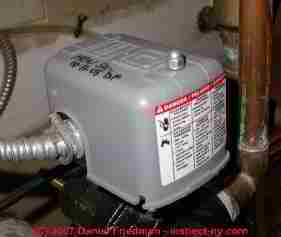 Watch out: while a single on-off click is normal for pressure switch operation, a pump pressure control switch that buzzes or chatters is sick and needs repair or replacement.
Watch out: while a single on-off click is normal for pressure switch operation, a pump pressure control switch that buzzes or chatters is sick and needs repair or replacement.
See complete details
at WATER PUMP PRESSURE CONTROL SWITCH CHATTER - topic home.
Examples of some key switch chatter or bounce causes are given below. Our full list is in the article just cited above.
Schneider, discussing maintenance of their Square-D pressure control switch series offers these explanations and cures for a chattering pressure control switch (adapted):
- Incorrect air pressure in an internal-bladder type pressure tank: check and correct the tank pre-charge pressure, set it to 2 psi below the switch cut-in pressure.
See WATER TANK AIR HOW MUCH TO ADD - Waterlogged pressure tank (for bladderless pressure tanks or for a pressure tank with a burst or leaky internal bladder)
See WATER PUMP SHORT CYCLING - Switch exposed to vibration, for example from a pump or due to poorly-secured piping.
Isolate the pressure switch by using vibration-isolation mounts (available from plumbing suppliers). Also check that the pump mounts are in good condition and that the pump itself is not damaged. Excessive pump vibration may indicate a failing impeller or pump bearing.
Reference: "Preventive Maintenance and Troubleshooting Guidelines for Class 9013F and 9013G Pressure Switches" (2007), Original source: Schneider Electric USA 8001 Knightdale Boulevard Knightdale, NC 27545 USA 1-888-SquareD (1-888-778-2733) www.us.SquareD.com
- Primary pump control box relay switch chattering may also occur in the primary well pump relay switch that is used to power higher horsepower (usually submersible) water pumps such as the green-labeled pump control unit shown in the center of our photograph below.
Where installed, the primary pump control relay in this separate control box is itself activated by the pump pressure control switch shown above.
See WATER PUMP PRESSURE CONTROL SWITCH for installation, adjustment, troubleshooting & repair of well or water pump control switches.
The water pump control relay switch is illustrated separately and in more detail
Sources of Replacement Contactors & Relay Controls
- First check with your local HVAC or plumbing supplier
- Also check with local building suppliers such as Home Depot, Lowes, or local hardware stores and electrical suppliers
- Automotive air conditioning relays are available from your local automobile or truck parts supplier or from similar online vendors. Check Autozone and Oreilly Auto.
- One of the largest online vendors of contactors and relays for just about every application in equipment used in or around buildings is Grainger, a supplier with supply sources worldwide and where we found some of our contactor type illustrations. Customer Service: 1-800-472-4643 Website: https://www.grainger.com
Field Report: Chattering Buzzing Sound Repair at Compressor/Condenser Unit
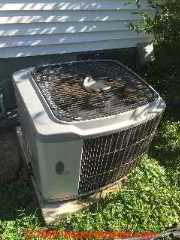 Question: intermittent chatter, swapped out by changing contactor, more trouble
Question: intermittent chatter, swapped out by changing contactor, more trouble
Great site and thorough set of diagnostic resources! I wasn't able to find a noise similar to what my system is doing on your site, so I figured that you may be able to add it to your library...if someone knows what it could be, even better!
Prior to this set of sounds, I was getting an intermittent chatter, which was resolved by swapping out the contactor and cleaning all electrical contacts. Now I'm getting this noise (attached), which was not resolved by changing thermostats (Had a Nest, and was suspicious that it may be a software based issue - Installed honeywell rth221b).
Seems to be sporadic as to the timing, but I tend to hear it at night - perhaps primarily due to the fact that I'm in the house, and it's quiet.
[Click to enlarge any image]
Temperature is cool enough right now to get by with fans while I figure it out and before I break down and pay someone for a diagnosis! Any info you have is helpful. - Anonymous by private email 2016/07/19
A/C COMPRESSOR RATTLE CHATTER NOISE [.MOV file] sound recording (no image) [314 KB]
Reply:
I'll look at the video, and post with comments and send you that link for comment. Thank you so much.
About remaining chatter (comment more after seeing video), it's easy enough to take the thermostat out of the equation: just disconnect it entirely at the appliance-end and jump the two TT wire terminals together at the appliance - that's the same as the thermostat calling for cooling (or heating or whatever).
Also see NOISES, HVAC SOUND RECORDINGS
Also see FAN NOISES, HVAC as ticking and chattering may be traced to a fan problem.
Reader follow-up: suspect voltage issues
Thanks... - the thermostat was a necessary buy in the next 12 months anyways assuming our housing plans come through as we hope - we liked the nest and had no issues with it last year or all winter, and plan to take it with us!
My neighbor is a commercial hvac guy so we're going to climb under the house tonight and see if we can take a look - I'll update you if we get anywhere! - 2016/07/19
We believe that the issue is a low voltage power issue, as the sound is most definitely the contactor arcing and rapidly engaging/disengaging. We thought that we found the issue in a loose connection at a wire nut - when we unscrewed it, the connected wires were actually broken off and stayed in the nut when we took the cap off.
We unscrewed, cleaned, re-stripped, and re-connected all of the connections, but are still getting the issue. We've got a fan control unit (white rodgers 90-113 if I'm calling it the wrong thing here) on order, as a colleague of my neighbor suggested that as the next logical step in the circuit.
Some additional information about my unit - it's an older carrier system (~20 years or so), and has both a high and low pressure safety? (neighbor seemed surprised by that) so figured it worth mentioning. I may be getting some of this confused since I'm translating from memory, but I figure if you know what you're talking about you can probably make heads and tails of it all.
Thanks - I'll keep you posted once we get the fan control unit in. If I have a chance to get a video of the chattering contactor with the lid removed, I'll send it on over. - 2016/07/20
Moderator reply:
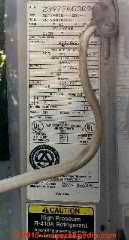 Thanks for the update. The "safety" controls to which you refer are probably pressure sensors that shut off the compressor if the system pressure indicates malfunction or unsafe conditions. Those controls can also produce a hissing sound if they operate.
Thanks for the update. The "safety" controls to which you refer are probably pressure sensors that shut off the compressor if the system pressure indicates malfunction or unsafe conditions. Those controls can also produce a hissing sound if they operate.
Look closely at the circuit board; even a non-E.E. can sometimes spot trouble such as a burned component on the board - dark brown or black areas. The bad relay you described can be either a root cause of trouble or it can itself be burned and damaged by something else that is too frequently trying to turn a piece of equipment on and off.
Do keep me posted, and stay safe.
Shown here: the data tag for the air conditioner compressor/condenser unit being discussed.
[Click to enlarge any image]
Reader follow-up: hot seized compressor
Came home from a weekend away to a hot, seized compressor. Hoping for the best and giving it the night to cool down and try a restart in the AM. The low voltage issue we suspected sounds an awful lot like the info you have on hard starts, so it sounds like we may end up a bit pricier than I had hoped.
Moderator reply:
A working theory is that a relay or other component is chattering because it's trying to switch on and start a motor that just won't behave.
There is a tremendous industry selling hard-start capacitors to give recalcitrant motors an extra kick in the seat of the pants. I am usually suspicions that we're throwing good money after bad.
Provided we first rule out a simple failure of the actual normal start/run capacitor, then if a motor's bearings or some other parts are failing so that the motor is resistant to starting, giving it a bigger voltage jolt may get it going but it's still a motor headed to failure.
Once a motor has seized at all, even if we get it going again by cooling down, and with some motors, squirting in some oil, I think the damage is already done.
Installing a hard-start cap is relatively inexpensive and easy so it's not ridiculous to try that, and it may indeed give some extended life to a failing and expensive part, but I'm just sayin'.
Reader follow-up:
No Dice on the restart. Got the compressor, coolant, drier, etc. on order and will be doing the replacement this weekend. Fingers crossed this solves the chattering issue as well and that it's not a low voltage problem. - 2016/07/27
Moderator reply:
Someone checked voltage, right? That's easy enough to do. Also a check of the current draw when the compressor is trying to start is a powerful diagnostic. Very high amps might be read if a motor is seizing.
Also a check of pressures is important. E.g. if an expansion valve has failed a compressor can have trouble re-starting against high head pressure.
Reader follow-up: problem solved:
Thanks for the advice (and yeah, we checked voltage on day 2 when my neighbor brought his work toolbox home). I'll make sure to mention the pressure check also! As always, will keep you posted with updates until we get it figured out - hopefully this will ultimately be a helpful resource for your site - 2016/07/28
Switched out the compressor, drier, capacitor, and relay on the furnace that we hadn't switched out already (it was for the heat and shouldn't have had any impact, but while you're in there...), and had previously switched out the contactor and fan control unit. Cleaned up some wiring connections, Got it charged back up and we're blowing cold air again!
Total parts cost ~750, plus $300 labor...certainly cheaper than a new unit! Thanks for all of your help and advice, and I hope this helps someone else down the road! 0 2016/08/01
Moderator reply:
Congrats; those repair costs sound surprisingly low, especially including the compressor motor. I'll post your discussion
at A/C CONDENSER CHATTER / BUZZ REPAIR SUCCESS as that will certainly help other readers
Special Thanks: to Alan Carson, Carson Dunlop Associates, for technical review, comments, questions that improved the content and accuracy of this article. August 2016.
- Carson, Dunlop & Associates Ltd., 120 Carlton Street Suite 407, Toronto ON M5A 4K2. (416) 964-9415 1-800-268-7070 info@carsondunlop.com. The firm provides professional HOME INSPECTION SERVICES, HOME INSPECTION TRAINING, Horizon INSPECTION SOFTWARE & PUBLICATIONS.Alan Carson is a past president of ASHI, the American Society of Home Inspectors.
Reader Comments, Questions & Answers About The Article Above
Below you will find questions and answers previously posted on this page at its page bottom reader comment box.
Reader Q&A - also see RECOMMENDED ARTICLES & FAQs
On 2021-01-19 - by (mod) -
Good point, G.V. I'd give a call to the service manager at your service company, discuss the recurrence of this failure, and ask that she send out a senior tech who can track down the underlying issue, such as a failing compressor motor, improper refrigerant charge, failed TEV etc.
On 2021-01-19 by G.vernon
My a.c./heat pump unit seams to chatter badly in heat mode, my repair company has changed the contactors several times (like every year). Seams like there must be another issue .
On 2020-08-24 by Matt
Need to find replacement for this part
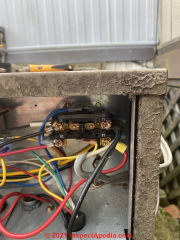
On 2020-08-09 by JimL - Trane A/C contact switch starting rapidly clicking
My Trane A/C contact switch starting rapidly clicking this weekend. After shutting off the power I inspected the switch and the wiring. Both looked good. Coincidentally I just had a new fan motor installed 2 weeks ago so I thought for sure the issue was related to the new fan motor. It talking to a friend who works with A/C controls, he asked "how old is your thermostat and have you replaced the batteries".
The thermostat is old, about 23 years old. I replaced all 3 AA batteries in the old thermostat and to my surprise the outside contact switch quit clicking when the outside unit is running. In my case this was an easy fix and I got lucky this time.
On 2019-10-11 - by (mod) -
Sounds like a bad fan motor.
It also sounds as if you were working on your equipment without turnng the power off -- which could easily shocked or kill you.
On 2019-10-11 by Steve
My AC stopped working, The fan would not run at all. I have replaced the capacitor and the relay switch. When I first take capacitor out, the relay switch started clicking or chattering noises. I had to unplug the wires to the relay.
After replaced with new capacitor, the fan started working, but the noise on the relay never stopped.
As a result, the output tube keep showing white frozen ice. Then I bought a brand new relay switch, the noise is there. I checked the voltage, it is 24V.
What else should I look for now?
On 2019-10-04 by (mod) - fan/blower in Sharp split type aircon unit makes click sound
I agree that this sounds like a control cycling;
but is it possible that there's an electrostatic air cleaner installed? Those devices make periodic snap or click sounds too.
On 2019-09-24 by Adrian
The interior fan/blower component of my Sharp split type aircon unit makes a single click sound every few minutes. It sounds very much like a switch and it's the exact same sound it makes when I turn the unit off (not the beep from the remote but what sounds like a switch in the unit itself). Other relevant facts:
1. When I had the unit cleaned/serviced, the problem was much reduced but it still happens.
2. The higher the fan speed the less often it occurs. On max fan it never clicks.
Most people would not consider this a problem but for light neurotic sleeps it is. It's anticipating the sound and loud enough to wake me up if falling asleep but not if in a deep sleep.
What is this? Can I replace this part? Can I muffle it somehow?
...
Continue reading at NOISES, HVAC SYSTEM DIAGNOSIS or select a topic from the closely-related articles below, or see the complete ARTICLE INDEX.
Or see RELAY CONTROL SWITCH FAQs - questions & answers posted originally at this page.
Or see these
Recommended Articles
- A/C COMPRESSOR RATTLE CHATTER NOISE [.MOV file] sound recording (no image) [314 KB]
- A/C CONDENSER CHATTER / BUZZ REPAIR SUCCESS
- BUZZING NOISE DIAGNOSIS - topic home
- CAR / TRUCK AC PRESSURE SWITCH
- CAPACITORS for HARD STARTING MOTORS
- CHATTERING RELAY CONTROL SWITCHES - home
- CHATTERING RELAYS, HVAC EQUIPMENT
- CHATTERING WATER PRESSURE CONTROL SWITCH
- HEATING SYSTEM BUZZING NOISE - buzzing relays in heater controls
- HUMMING NOISES in BUILDINGS - topic home
- NOISES, HVAC SOUND RECORDINGS
- FAN NOISES, HVAC - ticking and chattering may be traced to a fan problem.
- WATER PUMP PRESSURE CONTROL SWITCH CHATTER
Suggested citation for this web page
RELAY CONTROL SWITCHES at InspectApedia.com - online encyclopedia of building & environmental inspection, testing, diagnosis, repair, & problem prevention advice.
Or see this
INDEX to RELATED ARTICLES: ARTICLE INDEX to AIR CONDITIONING & HEAT PUMPS
Or use the SEARCH BOX found below to Ask a Question or Search InspectApedia
Or see
INDEX to RELATED ARTICLES: ARTICLE INDEX to BUILDING NOISE DIAGNOSIS
Or use the SEARCH BOX found below to Ask a Question or Search InspectApedia
Or see
INDEX to RELATED ARTICLES: ARTICLE INDEX to WATER SUPPLY, PUMPS TANKS WELLS
Or use the SEARCH BOX found below to Ask a Question or Search InspectApedia
Ask a Question or Search InspectApedia
Try the search box just below, or if you prefer, post a question or comment in the Comments box below and we will respond promptly.
Search the InspectApedia website
Note: appearance of your Comment below may be delayed: if your comment contains an image, photograph, web link, or text that looks to the software as if it might be a web link, your posting will appear after it has been approved by a moderator. Apologies for the delay.
Only one image can be added per comment but you can post as many comments, and therefore images, as you like.
You will not receive a notification when a response to your question has been posted.
Please bookmark this page to make it easy for you to check back for our response.
Our Comment Box is provided by Countable Web Productions countable.ca
Citations & References
In addition to any citations in the article above, a full list is available on request.
- "Solid State Relays Common Precautions" [PDF], Omron Management Center of America
2895 Greenspoint Parkway, Suite 100, Hoffman Estates, IL 60169
TEL: 1-224-520-7650 FAX: 1-224-520-7680,
OMRON Electronics LLC (Omron Automation - Americas) 2895 Greenspoint Parkway, Suite 200, Hoffman Estates, IL 60169 TEL: 1-847-843-7900 FAX: 1-847-843-8568/7787
Omron Corporation has offices world wide, retrieved 2016/.08/03, original source: https://www.omron.com/ecb/products/pdf/precautions_ssr.pdf - Barrett, P. G., and P. A. Collins. "Troubleshooting low voltage controls." In Pulp and Paper Industry Technical Conference, 1992., Conference Record of 1992 Annual, pp. 103-107. IEEE, 1992.
Abstract:
Control components are a vital aspect of any industrial process. It is argued that costly shutdowns can be minimized or eliminated through a complete understanding of the control devices along with a conscientious maintenance program and troubleshooting procedure. The electromechanical design of various types of starters, contactors, and overload relays are analyzed in terms of operation, application maintenance and troubleshooting. Specific suggestions for troubleshooting procedures are offered for various problem scenarios. - Carfagno, S. P., and G. Erich Heberlein. "A Study of the Effect of Aging on the Operation of Switching Devices." IEEE Transactions on Power Apparatus and Systems 6 (1980): 2272-2280.
Abstract:
An experimental study was conducted to determine whether equipment aging affects the vulnerability of electric switching devices to malfunction caused by vibratory stresses in the range of seismic frequencies and acceleration amplitudes. The study included a vibration test before and after a program of accelerated aging designed to simulate forty years of service in areas outside the containment of a nuclear power generating station. Gamma irradiation, thermal aging, electrical/mechanical cycling and simulation of operating basis earth- quakes were included in the program of accelerated aging. Malfunction was defined as spurious opening or closing of contacts for times in excess of 1 ms during the vibration tests. - Elphick, Sean, Vic Smith, Vic Gosbell, Gerrard Drury, and Sarath Perera. "Voltage sag susceptibility of 230 V equipment." IET Generation, Transmission & Distribution 7, no. 6 (2013): 576-583.
- Feldbauer, B. "The design of contactors with regard to their industrial application." Electrical Engineers-Part II: Power Engineering, Journal of the Institution of 95, no. 46 (1948): 439-448.
Abstract:
Modern contactor design is reviewed and reference is made to the influence which various applications of contactor type control gear have had on design and development. After a general survey the special considerations appertaining to motor-control duty are examined in detail, having due regard to the extreme cases which frequently occur in practice. Arc control and contact developments are mentioned, and a short discussion of the oil-immersed contactor follows with particular reference to its use in chemical plants and for high voltage. Some special contactor designs are discussed, as well as the problems arising in connection with the control of electric furnaces. A short summary of the desirable features of contactor auxiliary switches concludes the paper. - Haines, Roger W., and Douglas C. Hittle. "Electric and Electronic Control Devices." In Control Systems for Heating, Ventilating, and Air Conditioning, pp. 42-67. Springer US, 1993.
- Herman, Stephen. Electric motor control. Cengage Learning, 2014.
- Knights, D. S. "Relays & Contacts." In Component Reliability, pp. 45-56. Macmillan Education UK, 1971.
- Kreveld, Phil. "Relays and Contractors: From Little Things Big Things Grow." Electrical Connection Winter Quarter 2008 (2008): 28.
- Lee, Yim-Shu, Hon-Chee So, and Martin HL Chow. "Design of AC voltage sag compensators." In Power Electronics and Motion Control Conference, 2009. IPEMC'09. IEEE 6th International, pp. 2587-2590. IEEE, 2009.
Abstract:
AC operated electronic equipment are vulnerable to momentary losses of AC voltage, which are known as voltage sags. Voltage sags are commonly caused by lightning, accidental short circuit, loose connection, starting of large motors (or air-conditioners) or abnormal use of the AC mains. In sensitive and critical applications, such as semiconductor material processing and medical operation, voltage sags may result in serious problems. In order to tackle this problem, the Semiconductor Equipment and Materials International (SEMI) defined, in 1996, a voltage sag immunity standard, known as SEMI F47-0200, for semiconductor processing equipment manufacturers to conform to. Equipment compliant to this standard must have the specified immunity characteristics against voltage sags without the use of batteries. Based on the experience learned, the standard was redefined, in 2006, as SEMI F47-0706. It is expected that new semiconductor processing equipment will be designed to be compliant to the new standard. It is also likely that the SEMI F47-0706 requirement will be extended to other application areas. This paper describes the design of voltage sag compensators which can be operated in conjunction with a piece of equipment for SEMI F47 compliance. The voltage sag compensators described can provide sine-wave AC backup power to enable electronic equipment to meet the SEMI F47-0706 standard and to tolerate 100% momentary loss of AC mains voltage. - National Electrical Code (NEC) for the U.S., Article 430 Air Conditioning and Refrigerating Equipment
- National Electrical Code (NEC) for the U.S., Article 440 Air Conditioning and Refrigerating Equipment
- Roberts, HC, BG Liptak, and WP Durden. "5.9 Relays." [PDF] (2006).
- Taylor, Carson W. "Concepts of undervoltage load shedding for voltage stability." IEEE Transactions on Power Delivery 7, no. 2 (1992): 480-488.
- In addition to citations & references found in this article, see the research citations given at the end of the related articles found at our suggested
CONTINUE READING or RECOMMENDED ARTICLES.
- Carson, Dunlop & Associates Ltd., 120 Carlton Street Suite 407, Toronto ON M5A 4K2. Tel: (416) 964-9415 1-800-268-7070 Email: info@carsondunlop.com. Alan Carson is a past president of ASHI, the American Society of Home Inspectors.
Thanks to Alan Carson and Bob Dunlop, for permission for InspectAPedia to use text excerpts from The HOME REFERENCE BOOK - the Encyclopedia of Homes and to use illustrations from The ILLUSTRATED HOME .
Carson Dunlop Associates provides extensive home inspection education and report writing material. In gratitude we provide links to tsome Carson Dunlop Associates products and services.


